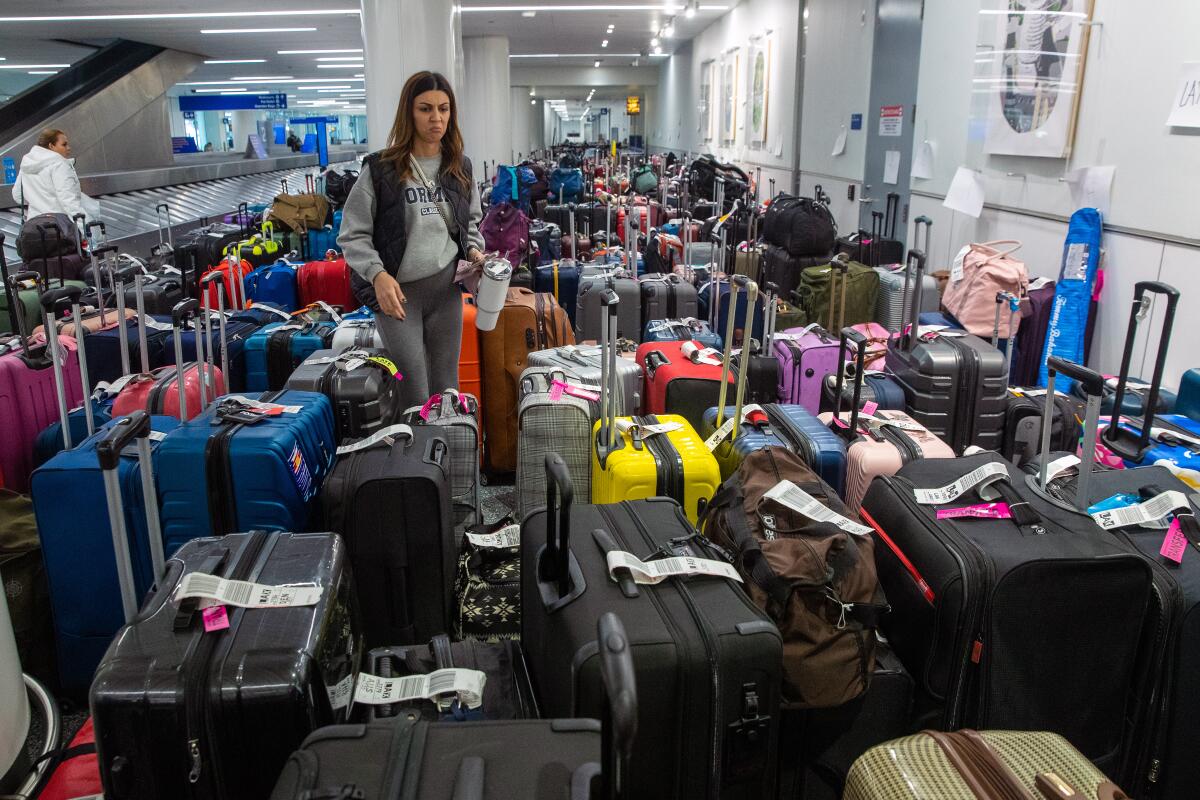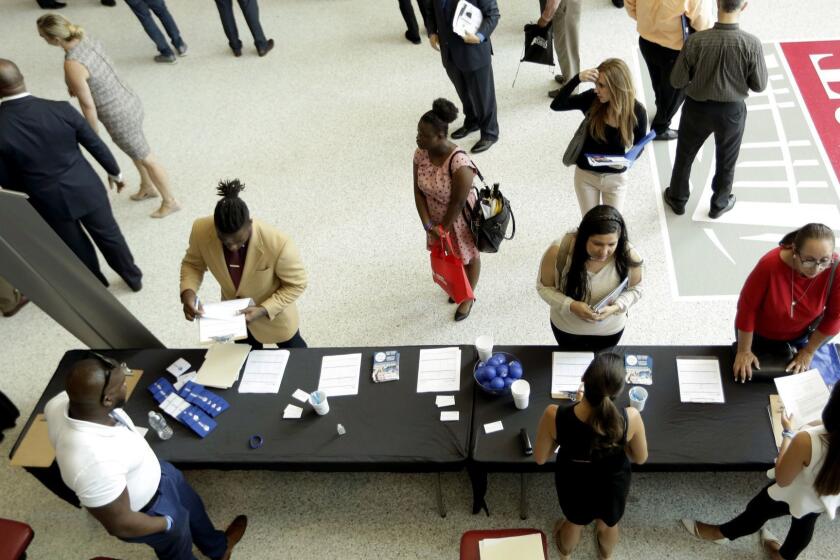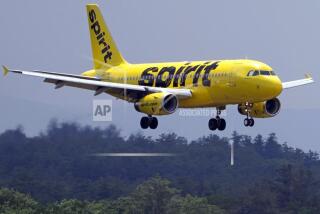Column: Southwest’s meltdown was born in America’s cheapskate corporate culture

- Share via
Through much of 2022, the most often asked questions about Southwest Airlines concerned issues such as whether it would allow preassigned seating, start charging for all checked baggage and institute change fees — scrapping all those policies that have made the airline unique.
Today, the question on Southwest passengers’ minds is: Will its planes get in the air at all?
Southwest’s yuletide meltdown has been so widely publicized that it doesn’t require a lengthy recap. Suffice to say that Wednesday, as I write, its 2,508 flight cancellations account for 90% of all domestic flight cancellations in the U.S. (The statistics are from FlightAware.)
We’ve talked an awful lot about modernizing the operation, and the need to do that.
— Southwest CEO Bob Jordan
On Tuesday, Southwest accounted for about 84% of the more than 3,200 domestic flight cancellations.
That trend implies that as the country’s other air carriers have begun to work out their own traffic snarls resulting from the massive “bomb cyclone” that struck the U.S. starting on the day before Christmas, Southwest remains mired in disaster. The airline says it will take days to work its way out.
Get the latest from Michael Hiltzik
Commentary on economics and more from a Pulitzer Prize winner.
You may occasionally receive promotional content from the Los Angeles Times.
One can’t blame Southwest for the magnitude of the storm, obviously.
One can, however, examine why the airline has done so much worse than its rivals, why the other carriers didn’t do so well either, and why American companies generally get caught so often with their pants down when operating conditions materialize on the edge of — or outside — normal expectations.
The short answer is their underinvestment in preparation and planning. For decades, Big Business has been squandering its resources on handouts to shareholders instead of spending on workers and infrastructure. There’s not enough give in the system, so when crisis comes, it doesn’t bend, but breaks.
Airlines cancel more than 2,800 flights Tuesday morning, the majority of them with Southwest. At LAX, the cancellations and delays create misery.
What drives this tendency is economics. Business managements have become hostages to cost-cutting, squeezing expenses out of their systems in every way possible, trusting to luck that what works under normal conditions will continue to work when the outside world goes haywire. They’re betting their companies on a bad strategy.
There are numerous manifestations of this cheeseparing habit. One is just-in-time production, which spread like wildfire from Toyota, where it originated in the 1980s, to the rest of the automobile industry and eventually to the manufacturing sector generally.
The idea was to slash waste by coordinating inventories of parts, the supply of workers and the time for production so that everything was in place when needed and not a minute before or after.
Starting last fall, passengers on Southwest Airlines’ usually reliable flights began noticing a sharp deterioration in on-time performance.
The pace of work sped up, workers were squeezed on wages and hours, parts suppliers operated on ever-narrower margins. It all worked fine, until it didn’t.
The dream of a production line “inherently flexible, inventoryless, even computerless, replenished by infinitely responsive suppliers” was too simple, Uday Karmarkar, an expert in manufacturing strategy and technology at UCLA’s Anderson School of Management, observed as long ago as 1989. “Just-in-time manufacturing is producing revolutionaries who don’t know when to stop.”
Beginning in the summer of 2021, logjams in the global supply chain, compounded by a surge in post-pandemic goods orders from consumers returning to shops, left manufacturers without needed parts and retailers without merchandise.
Only since that crisis erupted have manufacturers recognized that they need to move away from just-in-time to just-in-case — that is, keeping more parts inventory on-site and more workers, with better training, on call.
Another manifestation is outsourcing. Boeing could have learned the lesson that outsourcing can increase costs and place a heavy burden on management from its experience with its 787 Dreamliner.
The next-generation aircraft came in billions of dollars over budget and years behind schedule when it finally began to fly commercially in 2011, in part because Boeing farmed out more of the work to foreign contractors.
Some of the pieces manufactured by far-flung suppliers didn’t fit together. Some subcontractors couldn’t meet their output quotas, creating huge production logjams when crucial parts weren’t available in the necessary sequence.
“We gave work to people that had never really done this kind of technology before, and then we didn’t provide the oversight that was necessary,” Jim Albaugh, then the company’s commercial aviation chief, acknowledged. “The pendulum swung too far.”
Yet Boeing pursued an outsourcing strategy for crucial systems in its 737 Max. After the plane suffered two fatal crashes in 2018 and 2019 because of malfunctioning software, leading to a years-long grounding by aeronautics regulators around the world, Bloomberg reported that Boeing had outsourced its software development to overseas firms employing engineers for as little as $9 an hour.
UPDATE, July 12: In its latest report on wages, released Thursday, the Bureau of Labor Statistics said that earnings for all employees were unchanged in June from June 2017.
The company maintained that it was fully capable of supervising the foreign software engineers’ work. The Max is back in the air now and rolling out to customers, the largest of which is Southwest Airlines.
That brings us back to the Southwest meltdown. A full explanation may not emerge for some time, but it’s possible to identify some contributing factors.
One is the airline’s practice of operating with the tightest of operational constraints. Southwest has long prided itself on its short turnaround times between landings and takeoffs, aimed at maximizing the efficiency of its fleet and sometimes mandating turns as brief as 35 minutes.
Yet this is not the first time that the practice produced disaster. That would be 2014, when the carrier’s on-time performance suddenly cratered. The problem was that Southwest decided to cram many more flights into its schedule without expanding its aircraft fleet.
Its confidence stemmed from a relatively trouble-free performance during 2012, which was a mild weather year. But it soon became clear that the schedule’s demanding tolerances could be met only on days with near-perfect weather and no mechanical mishaps.
The airline built more flexibility into its schedule after that, but other factors came into play during the last week. They include Southwest’s point-to-point flight map, which differs from the hub-and-spoke configuration of other major carriers such as United and Delta, which concentrate operations at large regional airports such as Chicago and Atlanta.
That simplifies the challenge of coordinating aircraft and crews so they’re in place together, limiting (if not eliminating) the chance that local or regional weather crises will affect flights nationwide.
Southwest doesn’t have the same coordination capacity — and according to employees, its complex point-to-point system requires more robust scheduling technology than it has implemented.
“Our internal scheduling software can’t handle massive cancellations,” Michael Santoro, vice president of the Southwest pilots union, told my colleague Margot Roosevelt in an interview. “The company hasn’t invested the money into scheduling infrastructure to support the network they have developed.”
The outdated system is unequipped to handle rerouting involved in hundreds of cancellations, Santoro said. “So pilots are calling in asking, ‘I’m done with this flight — where do I go next? Am I running another plane? Do I spend the night here?’ And pilots are on hold for hours trying to figure out what to do next.”
787 Dreamliner teaches Boeing costly lesson on outsourcing
When the weather is perfect, the software matches crews to planes. “But when there’s a disruption like this storm, our system can’t handle it,” Michael Massoni, first vice president of Transport Workers Union Local 556, which represents Southwest flight attendants, told Roosevelt.
“Southwest loses control because we don’t have 21st century technology. So what happens is chaos. Southwest starts to deal with the problem manually, which is incredibly tedious.”
Southwest Chief Executive Bob Jordan acknowledged the software scheduling problem in a message to Southwest employees obtained by CNN.
“Part of what we’re suffering is a lack of tools,” Jordan said. “We’ve talked an awful lot about modernizing the operation, and the need to do that.”
What has the airline been spending money on, if not mission-critical corporate infrastructure? On dividends and stock buybacks, which flow directly to shareholders.
Early in December, the airline announced that it would reinstate its dividend — suspended during the pandemic — by paying 18 cents a share to investors in early January. The payout will cost nearly $107 million. Since 2015, the company has paid out about $1.6 billion in dividends and repurchased more than $8 billion in shares — that is, handouts to shareholders.
The dividend resumption may be cold comfort to Southwest stockholders, who have seen their shares sink in value by about 28% this year and by more than 18% just since Thanksgiving.
But it will send a chillier wind at its passengers, thousands of whom have been stranded at airports with no guarantee that they will be granted a seat on a Southwest flight for days to come and who may wish that Jordan stopped talking about modernizing the airline, and started acting.
More to Read
Get the latest from Michael Hiltzik
Commentary on economics and more from a Pulitzer Prize winner.
You may occasionally receive promotional content from the Los Angeles Times.














